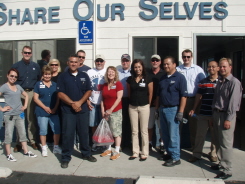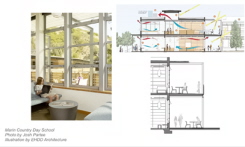So You Want to Be an Expert Witness

Ever wonder what it takes to become an expert witness? Think you maybe you have what it takes? In this 7-minute kTalk, David Brotman, FAIA, affably and thoroughly demystifies the routine of the expert witness. From who’s qualified to do it, the necessary character traits required to do it well, the ethics involved and the challenges you’ll face. Tune in to watch a seasoned expert witness explain the essentials.
| Presenter: |
David Brotman, Faia, Principal |
| Firm: |
Sunset Consultants |
| Knowledge Area: |
Practice Management |
| Duration: |
07:24 |
Making Pro-Bono Possible

While taking on a Pro-Bono project might be a philanthropic endeavor at its root, it’s also one that will be met with real world challenges such as budget constraints, volunteer morale, and how to best integrate distinct visions. In this 9-minute kTalk, Elise Drakes shares her insights and experiences in taking a pro-bono remodel from concept to completion as a Project Coordinator for Taylor. Find out how to get businesses and individuals to contribute time and money, how to solicit free artwork, and how to keep a volunteer workforce productive.
| Presenter: |
Elise Drakes, Project Manager |
| Firm: |
LPA, Inc. |
| Knowledge Area: |
Practice Management |
| Duration: |
08:43 |
How We Work Together

Workplace relationships are vital. They can mean the difference between high-performing teams and bankrupt companies, yet it’s a subject that gets little attention. In this 7-minute kTalk, Alyssa Scholz, Taylor’s Director of Interior Design, presents a philosophical yet practical approach for building honest, respectful relationships with colleagues. Learn your “Way of Being” in order to enjoy more effective collaboration, open communication and personal satisfaction in your working relationships.
| Presenter: |
Alyssa Scholz |
| Firm: |
TAYLOR |
| Knowledge Area: |
Practice Management |
| Duration: |
06:51 |
Working with the Media in Today’s 24/7 World

While understanding the media has long been the goal of successful companies, new technologies are bringing fourth new rules in today’s 24/7 media-focused world. In this 7-minute kTalk, Leeza Hoyt, media expert and President of Hoyt Organization, offers a wealth of sage advice for companies and individuals who need to understand, employ and leverage the power of traditional and new media.
| Presenter: |
Leeza Hoyt, President |
| Firm: |
The Hoyt Organization, Inc. |
| Knowledge Area: |
Practice Management |
| Duration: |
07:03 |
Getting Past Green

In this sobering and inspirational kTalk, Bill Leddy, FAIA, delivers an impassioned plea about global warming and that "business as usual" must end. Bill encourages design professionals to adopt a strategy to proactively combat climate change and get over our nation's increasing "green fatigue."
Bill warns us that, to the detriment of solving climate change dangers, architecture remains a divided profession about how to tackle sustainability, with separate award programs and educational studios for excellent design and green design. Bill challenges us to rethink many of our fundamental design aspirations and find new architectural languages that express and celebrate a post-carbon world.
| Presenter: |
William Leddy, Faia |
| Firm: |
Leddy Maytum Stacy Architects |
| Knowledge Area: |
Sustainability |
| Duration: |
08:58 |
Commissioning Buildings for Sustainability

When it comes to building, it's absolutely necessary that all phases of a project, planning through occupancy, are completed correctly. In this 10-minute kTalk, Ron Wilkinson, LEED AP, explains that while there is no absolute definition of quality, building commissioning is quality assurance. Find out how commissioning, through a means of programming and OPR, design checking and functional testing, can ensure the safety, functionality and sustainability of your building.
| Presenter: |
Ron Wilkinson, Commissioning Authority |
| Firm: |
AKF |
| Knowledge Area: |
Sustainability |
| Duration: |
09:53 |
Net Zero Energy and Future Challenges

In this excerpt from the continuing education course "Net Zero Energy and Future Challenges". Ken Powelson, Project Architect at EHDD Architects, walks us through a detailed case study of the Marin Country Day School--the first net zero energy classroom building in North America--and describes specific design and engineering strategies employed. He summarizes this case study with a series of lessons learned on this and other net zero facilities.
| Presenter: |
Ken Powelson, Project Manager |
| Firm: |
EHDD |
| Knowledge Area: |
Sustainability |
| Duration: |
09:43 |
California's New Sustainable Landscaping Legislation

In this enlightening kTalk, Cassy Aoyagi, LEED AP, discusses the challenges and opportunities presented by AB1881, California’s new Model Water Efficiency legislation aimed at curbing environmental degradation and rising energy costs. Aoyagi presents a multi-faceted strategy for achieving compliance while enhancing air and water quality, saving time and money, and increasing LEED Rankings without sacrificing design aesthetics or our fascination with water features.
| Presenter: |
Cassy Aoyagi, President |
| Firm: |
Theodore Payne Foundation/FormLA Landscaping |
| Knowledge Area: |
Codes / Specification |
| Duration: |
09:35 |
Specification Processes as Quality Assurance

Think specifications are nothing more than a book of standards, materials and methods? In this 9-minute kTalk, Michael Chambers, FAIA, makes the case that one of the most underutilized aspects of specifications is that of a quality assurance process for both the design and construction phases of a project. Learn how to use these processes and procedures as powerful tools to clearly and concisely communicate the critical aspects of design to your contractor.
| Presenter: |
Michael Chambers, Architect |
| Firm: |
MCA Specifications |
| Knowledge Area: |
Codes / Specification |
| Duration: |
08:49 |
Mentoring & The Small Architecture Practice

No matter the field, it's essential that a context is created for the exchange of ideas between generations. Never has this been so true as today in the field of architecture. In an age when the majority of architecture graduates plan to pursue alternative careers, the guidance of mentors is needed desperately by emerging professionals in the field. In this sobering but practical kTalk, Michael Bernard, AIA, discusses the importance of mentoring in the small practice. Whether it’s how to find the time to be a mentor, how to get young architects to seek mentors, or getting others to be a part of your mentorship network--Michael Bernard covers it all here in this five minute talk.
| Presenter: |
Michael Bernard, Principal |
| Firm: |
Virtual Practice Consulting |
| Knowledge Area: |
Career Stages |
| Duration: |
05:29 |














